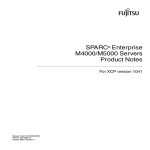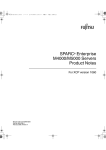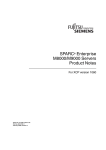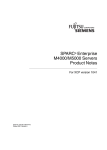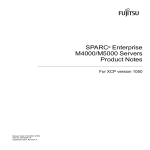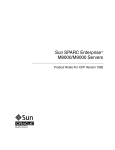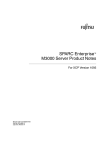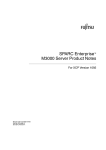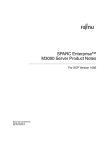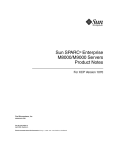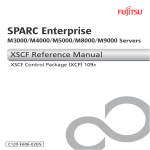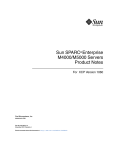Download Siemens M9000 User's Manual
Transcript
SPARC® Enterprise M8000/M9000 Servers Product Notes For XCP version 1072 Order No. U41813-J-Z816-1-76 Part No. 820-6008-10 September 2008, Revision A Copyright 2008 Sun Microsystems, Inc., 4150 Network Circle, Santa Clara, California 95054, U.S.A. and FUJITSU LIMITED, 1-1, Kamikodanaka 4-chome, Nakahara-ku, Kawasaki-shi, Kanagawa-ken 211-8588, Japan. All rights reserved. Sun Microsystems, Inc. and Fujitsu Limited each own or control intellectual property rights relating to products and technology described in this document, and such products, technology and this document are protected by copyright laws, patents and other intellectual property laws and international treaties. The intellectual property rights of Sun Microsystems, Inc. and Fujitsu Limited in such products, technology and this document include, without limitation, one or more of the United States patents listed at http://www.sun.com/patents and one or more additional patents or patent applications in the United States or other countries. This document and the product and technology to which it pertains are distributed under licenses restricting their use, copying, distribution, and decompilation. No part of such product or technology, or of this document, may be reproduced in any form by any means without prior written authorization of Fujitsu Limited and Sun Microsystems, Inc., and their applicable licensors, if any. The furnishing of this document to you does not give you any rights or licenses, express or implied, with respect to the product or technology to which it pertains, and this document does not contain or represent any commitment of any kind on the part of Fujitsu Limited or Sun Microsystems, Inc., or any affiliate of either of them. This document and the product and technology described in this document may incorporate third-party intellectual property copyrighted by and/or licensed from suppliers to Fujitsu Limited and/or Sun Microsystems, Inc., including software and font technology. Per the terms of the GPL or LGPL, a copy of the source code governed by the GPL or LGPL, as applicable, is available upon request by the End User. Please contact Fujitsu Limited or Sun Microsystems, Inc. This distribution may include materials developed by third parties. Parts of the product may be derived from Berkeley BSD systems, licensed from the University of California. UNIX is a registered trademark in the U.S. and in other countries, exclusively licensed through X/Open Company, Ltd. Sun, Sun Microsystems, the Sun logo, Java, Netra, Solaris, Sun Ray, Answerbook2, docs.sun.com, OpenBoot, and Sun Fire are trademarks or registered trademarks of Sun Microsystems, Inc. in the U.S. and other countries. Fujitsu and the Fujitsu logo are registered trademarks of Fujitsu Limited. All SPARC trademarks are used under license and are registered trademarks of SPARC International, Inc. in the U.S. and other countries. Products bearing SPARC trademarks are based upon architecture developed by Sun Microsystems, Inc. SPARC64 is a trademark of SPARC International, Inc., used under license by Fujitsu Microelectronics, Inc. and Fujitsu Limited. The OPEN LOOK and Sun™ Graphical User Interface was developed by Sun Microsystems, Inc. for its users and licensees. Sun acknowledges the pioneering efforts of Xerox in researching and developing the concept of visual or graphical user interfaces for the computer industry. Sun holds a non-exclusive license from Xerox to the Xerox Graphical User Interface, which license also covers Sun’s licensees who implement OPEN LOOK GUIs and otherwise comply with Sun’s written license agreements. United States Government Rights - Commercial use. U.S. Government users are subject to the standard government user license agreements of Sun Microsystems, Inc. and Fujitsu Limited and the applicable provisions of the FAR and its supplements. Disclaimer: The only warranties granted by Fujitsu Limited, Sun Microsystems, Inc. or any affiliate of either of them in connection with this document or any product or technology described herein are those expressly set forth in the license agreement pursuant to which the product or technology is provided. EXCEPT AS EXPRESSLY SET FORTH IN SUCH AGREEMENT, FUJITSU LIMITED, SUN MICROSYSTEMS, INC. AND THEIR AFFILIATES MAKE NO REPRESENTATIONS OR WARRANTIES OF ANY KIND (EXPRESS OR IMPLIED) REGARDING SUCH PRODUCT OR TECHNOLOGY OR THIS DOCUMENT, WHICH ARE ALL PROVIDED AS IS, AND ALL EXPRESS OR IMPLIED CONDITIONS, REPRESENTATIONS AND WARRANTIES, INCLUDING WITHOUT LIMITATION ANY IMPLIED WARRANTY OF MERCHANTABILITY, FITNESS FOR A PARTICULAR PURPOSE OR NON-INFRINGEMENT, ARE DISCLAIMED, EXCEPT TO THE EXTENT THAT SUCH DISCLAIMERS ARE HELD TO BE LEGALLY INVALID. Unless otherwise expressly set forth in such agreement, to the extent allowed by applicable law, in no event shall Fujitsu Limited, Sun Microsystems, Inc. or any of their affiliates have any liability to any third party under any legal theory for any loss of revenues or profits, loss of use or data, or business interruptions, or for any indirect, special, incidental or consequential damages, even if advised of the possibility of such damages. DOCUMENTATION IS PROVIDED “AS IS” AND ALL EXPRESS OR IMPLIED CONDITIONS, REPRESENTATIONS AND WARRANTIES, INCLUDING ANY IMPLIED WARRANTY OF MERCHANTABILITY, FITNESS FOR A PARTICULAR PURPOSE OR NONINFRINGEMENT, ARE DISCLAIMED, EXCEPT TO THE EXTENT THAT SUCH DISCLAIMERS ARE HELD TO BE LEGALLY INVALID. Please Recycle Copyright 2008 Sun Microsystems, Inc., 4150 Network Circle, Santa Clara, California 95054, U.S.A. et FUJITSU LIMITED, 1-1, Kamikodanaka 4-chome, Nakahara-ku, Kawasaki-shi, Kanagawa-ken 211-8588, Japon. Tous droits réservés. Entrée et revue tecnical fournies par Fujitsu Limited sur des parties de ce matériel. Sun Microsystems, Inc. et Fujitsu Limited détiennent et contrôlent toutes deux des droits de propriété intellectuelle relatifs aux produits et technologies décrits dans ce document. De même, ces produits, technologies et ce document sont protégés par des lois sur le copyright, des brevets, d’autres lois sur la propriété intellectuelle et des traités internationaux. Les droits de propriété intellectuelle de Sun Microsystems, Inc. et Fujitsu Limited concernant ces produits, ces technologies et ce document comprennent, sans que cette liste soit exhaustive, un ou plusieurs des brevets déposés aux États-Unis et indiqués à l’adresse http://www.sun.com/patents de même qu’un ou plusieurs brevets ou applications brevetées supplémentaires aux États-Unis et dans d’autres pays. Ce document, le produit et les technologies afférents sont exclusivement distribués avec des licences qui en restreignent l’utilisation, la copie, la distribution et la décompilation. Aucune partie de ce produit, de ces technologies ou de ce document ne peut être reproduite sous quelque forme que ce soit, par quelque moyen que ce soit, sans l’autorisation écrite préalable de Fujitsu Limited et de Sun Microsystems, Inc., et de leurs éventuels bailleurs de licence. Ce document, bien qu’il vous ait été fourni, ne vous confère aucun droit et aucune licence, expresses ou tacites, concernant le produit ou la technologie auxquels il se rapporte. Par ailleurs, il ne contient ni ne représente aucun engagement, de quelque type que ce soit, de la part de Fujitsu Limited ou de Sun Microsystems, Inc., ou des sociétés affiliées. Ce document, et le produit et les technologies qu’il décrit, peuvent inclure des droits de propriété intellectuelle de parties tierces protégés par copyright et/ou cédés sous licence par des fournisseurs à Fujitsu Limited et/ou Sun Microsystems, Inc., y compris des logiciels et des technologies relatives aux polices de caractères. Par limites du GPL ou du LGPL, une copie du code source régi par le GPL ou LGPL, comme applicable, est sur demande vers la fin utilsateur disponible; veuillez contacter Fujitsu Limted ou Sun Microsystems, Inc. Cette distribution peut comprendre des composants développés par des tierces parties. Des parties de ce produit pourront être dérivées des systèmes Berkeley BSD licenciés par l’Université de Californie. UNIX est une marque déposée aux Etats-Unis et dans d’autres pays et licenciée exclusivement par X/Open Company, Ltd. Sun, Sun Microsystems, le logo Sun, Java, Netra, Solaris, Sun Ray, Answerbook2, docs.sun.com, OpenBoot, et Sun Fire sont des marques de fabrique ou des marques déposées de Sun Microsystems, Inc. aux Etats-Unis et dans d’autres pays. Fujitsu et le logo Fujitsu sont des marques déposées de Fujitsu Limited. Toutes les marques SPARC sont utilisées sous licence et sont des marques de fabrique ou des marques déposées de SPARC International, Inc. aux Etats-Unis et dans d’autres pays. Les produits portant les marques SPARC sont basés sur une architecture développée par Sun Microsystems, Inc. SPARC64 est une marques déposée de SPARC International, Inc., utilisée sous le permis par Fujitsu Microelectronics, Inc. et Fujitsu Limited. L’interface d’utilisation graphique OPEN LOOK et Sun™ a été développée par Sun Microsystems, Inc. pour ses utilisateurs et licenciés. Sun reconnaît les efforts de pionniers de Xerox pour la recherche et le développement du concept des interfaces d’utilisation visuelle ou graphique pour l’industrie de l’informatique. Sun détient une license non exclusive de Xerox sur l’interface d’utilisation graphique Xerox, cette licence couvrant également les licenciés de Sun qui mettent en place l’interface d’utilisation graphique OPEN LOOK et qui, en outre, se conforment aux licences écrites de Sun. Droits du gouvernement américain - logiciel commercial. Les utilisateurs du gouvernement américain sont soumis aux contrats de licence standard de Sun Microsystems, Inc. et de Fujitsu Limited ainsi qu’aux clauses applicables stipulées dans le FAR et ses suppléments. Avis de non-responsabilité: les seules garanties octroyées par Fujitsu Limited, Sun Microsystems, Inc. ou toute société affiliée de l’une ou l’autre entité en rapport avec ce document ou tout produit ou toute technologie décrit(e) dans les présentes correspondent aux garanties expressément stipulées dans le contrat de licence régissant le produit ou la technologie fourni(e). SAUF MENTION CONTRAIRE EXPRESSÉMENT STIPULÉE DANS CE CONTRAT, FUJITSU LIMITED, SUN MICROSYSTEMS, INC. ET LES SOCIÉTÉS AFFILIÉES REJETTENT TOUTE REPRÉSENTATION OU TOUTE GARANTIE, QUELLE QU’EN SOIT LA NATURE (EXPRESSE OU IMPLICITE) CONCERNANT CE PRODUIT, CETTE TECHNOLOGIE OU CE DOCUMENT, LESQUELS SONT FOURNIS EN L’ÉTAT. EN OUTRE, TOUTES LES CONDITIONS, REPRÉSENTATIONS ET GARANTIES EXPRESSES OU TACITES, Y COMPRIS NOTAMMENT TOUTE GARANTIE IMPLICITE RELATIVE À LA QUALITÉ MARCHANDE, À L’APTITUDE À UNE UTILISATION PARTICULIÈRE OU À L’ABSENCE DE CONTREFAÇON, SONT EXCLUES, DANS LA MESURE AUTORISÉE PAR LA LOI APPLICABLE. Sauf mention contraire expressément stipulée dans ce contrat, dans la mesure autorisée par la loi applicable, en aucun cas Fujitsu Limited, Sun Microsystems, Inc. ou l’une de leurs filiales ne sauraient être tenues responsables envers une quelconque partie tierce, sous quelque théorie juridique que ce soit, de tout manque à gagner ou de perte de profit, de problèmes d’utilisation ou de perte de données, ou d’interruptions d’activités, ou de tout dommage indirect, spécial, secondaire ou consécutif, même si ces entités ont été préalablement informées d’une telle éventualité. LA DOCUMENTATION EST FOURNIE “EN L’ETAT” ET TOUTES AUTRES CONDITIONS, DECLARATIONS ET GARANTIES EXPRESSES OU TACITES SONT FORMELLEMENT EXCLUES, DANS LA MESURE AUTORISEE PAR LA LOI APPLICABLE, Y COMPRIS NOTAMMENT TOUTE GARANTIE IMPLICITE RELATIVE A LA QUALITE MARCHANDE, A L’APTITUDE A UNE UTILISATION PARTICULIERE OU A L’ABSENCE DE CONTREFACON. Contents Preface vii Technical Support vii Software Resources vii Accessing Documentation viii Fujitsu Siemens Computers Welcomes Your Comments General Information about XCP 1 Supported Firmware and Operating System Solaris OS Patch Information 1 2 Patches for SPARC64 VI Processors Patches for SPARC64 VII Processors Updating to XCP viii 2 2 3 Resetting the XSCF Firmware 3 Updating from a Version Earlier Than XCP 1050 3 Updating from a Version Earlier Than XCP 1070 4 Functionality Issues and Limitations 4 Limitations for SPARC64 VII Processors 4 General Functionality Issues and Limitations Information about Hardware 4 7 v Hardware Issues and Workarounds 7 Sun Crypto Accelerator 6000 Cards Information about Software XCP Issues and Workarounds 7 8 8 Solaris OS Issues and Workarounds Software Documentation Updates 12 27 Identifying Degraded Memory in a System 29 Identifying Different Memory Sizes in a System Board Using the showdevices Command 29 29 Using the prtdiag Command to Identify Memory Size Identifying Permanent Memory in a Target Board CPU Upgrade 30 31 32 Installation Notes 32 Updating the OpenBoot PROM Firmware With Processor Upgrade Adding SPARC64 VII Processors to a Domain Using DR 32 32 Adding a New CMU Equipped with SPARC64 VII as a New Domain 33 Upgrading an On-CMU SPARC64 VI to SPARC64 VII, or Adding SPARC64 VII to an Existing CMU, to an Existing Domain Configured with SPARC64 VI 35 Adding a New CMU Equipped with SPARC64 VII to an Existing Domain Configured with SPARC64 VI 38 vi SPARC Enterprise M8000/M9000 Servers Product Notes for XCP Version 1072 • September 2008 Preface These product notes contain late-breaking information about the SPARC® Enterprise M8000/M9000 server hardware, software, or documentation that became known after the documentation set was published. Technical Support If you have technical questions or issues that are not addressed in the SPARC Enterprise M8000/M9000 servers documentation, contact a sales representative or a certified service engineer. Software Resources The Solaris™ Operating System and Sun Java™ Enterprise System software are preinstalled on your SPARC Enterprise M8000/M9000 servers. Contact a sales representative or a certified service engineer for software resources for your SPARC Enterprise M8000/M9000 servers. Note – For latest patch information go to: http://support.fujitsu-siemens.com Installation information and README files are included in the patch download. vii Accessing Documentation Instructions for installing, administering, and using your SPARC Enterprise M8000/M9000 servers are provided in the SPARC Enterprise M8000/M9000 servers documentation set. The documentation set is available for download from the following website: http://manuals.fujitsu-siemens.com/ Note – Information in these product notes supersedes the information in the SPARC Enterprise M8000/M9000 servers documentation set. Solaris documentation is available at: http://www.sun.com/documentation Fujitsu Siemens Computers Welcomes Your Comments If you have any comments or requests regarding this manual, or if you find any unclear statements in the manual, please state your points specifically, and forward it to a sales representative or a certified service engineer. Please include the title and part number of your document with your feedback. viii SPARC Enterprise M8000/M9000 Servers Product Notes for XCP Version 1072 • September 2008 General Information about XCP 1072 This section describes the general information about XCP 1072. ■ ■ ■ Supported Firmware and Operating System Updating to XCP Functionality Issues and Limitations Supported Firmware and Operating System The following firmware and operating system (OS) are supported in this release. TABLE 1 Firmware and Operating System Versions Firmware and Operaing System Version XSCF Control Package (XCP) 1072 Solaris™ Operating System SPARC64 VI processors: 10 8/07 or later 10 11/06, with required patches SPARC64 VII processors: 10 5/08 or later 10 8/07, with required patches 1 Note – By using the Solaris 10 8/07 installation DVD, you cannot boot the domain mounted with the SPARC64 VII processors. When you newly install Solaris OS to a domain mounted with the SPARC64 VII processors, use the Solaris 10 5/08 installation DVD to install Solaris 10 5/08. For XCP, you can download the latest files of firmware at the following websites. Global Site: http://www.fujitsu.com/sparcenterprise/firmware/ Japanese Site: http://primeserver.fujitsu.com/sparcenterprise/download/firmware/ Solaris OS Patch Information This section lists mandatory patches for the SPARC Enterprise M8000/M9000 servers. Patches for SPARC64 VI Processors These patches are required for servers running Solaris 10 11/06. ■ ■ ■ ■ ■ ■ ■ 118833-36 (Install 118833-36 before 125100-04.) 125100-04 or later 120068-03 or later 123839-07 or later 125424-01 or later 125075-01 or later 125670-02 or later The patches are not required for servers running Solaris 10 8/07 OS or later. Patches for SPARC64 VII Processors These patches are required for servers running Solaris 10 8/07 and mounting SPARC64 VII processors. Note – Apply the patches in the following order. For the procedures of CPU upgrade including the patches, see “CPU Upgrade” on page 32. 2 SPARC Enterprise M8000/M9000 Servers Product Notes for XCP Version 1072 • September 2008 ■ ■ ■ ■ 119254-51 or later 125891-01 or later 127755-01 or later 127127-11 The patches are not required for servers running Solaris 10 5/08 OS or later. Note – See “Software Resources” on page vii for information on how to find the latest patches. Installation information and README files are included in the patch download. Patches for Emulex PCI-E Cards The following Emulex cards require drivers supplied in patch 120222-26: ■ XSEFC402AF Sun StorageTek Enterprise Class 4Gb Dual-Port Fibre Channel PCIE HBA ■ XSEFC401AF Sun StorageTek Enterprise Class 4Gb Single-Port Fibre Channel PCIE HBA Updating to XCP 1071 or Later To update your XCP to XCP 1071 or later, please pay attention to the following points depending on your current XCP version. You can upgrade to XCP 1071 or later from XCP version 1050 or higher. Refer to the SPARC Enterprise M4000/M5000/M8000/M9000 Servers XSCF User’s Guide for instructions. Resetting the XSCF Firmware After updating the XCP firmware to 1071 or later, do not fail to reset the XSCF by using the rebootxscf(8) command. General Information about XCP 1072 3 Updating from a Version Earlier Than XCP 1050 ■ You cannot update to XCP 1071 or later directly. If you are currently running a version earlier than XCP 1050, you must first update to an interim version of XCP between 1050 and 1070 (inclusive) before updating to XCP 1071 or later. Refer to the product notes document for the interim version for instructions. ■ Delete any accounts named "admin". Any accounts named admin must be deleted prior to updating to XCP 1050 or later. This account name is reserved in XCP 1050 and higher. Use the deleteuser(8) command to delete the account. Updating from a Version Earlier Than XCP 1070 On a domain which has been in operation during the XCP update to XCP 1071 or later, when you perform Dynamic Reconfiguration (DR) to add or replace the SPARC64 VII processors, you need to update the OpenBoot™ PROM firmware. The OpenBoot PROM firmware is updated as you update the XCP and restart the domain. For this reason, it is strongly recommended to restart all the domains after you update the firmware to XCP 1071 or later, regardless of whether you added or replaced the SPARC64 VII processors. Functionality Issues and Limitations This section describes the known issues and limitations at the time of this release. Limitations for SPARC64 VII Processors Caution – You must complete the upgrades to the XCP firmware and to Solaris OS before inserting the CPU/memory board unit of SPARC 64 VII processors into the chassis. On a SPARC Enterprise M9000 server, if a single domain includes 16 boards containing SPARC64 VII processors, then SunVTS 7.0ps2 software will not start. (CR ID: 6720922) 4 SPARC Enterprise M8000/M9000 Servers Product Notes for XCP Version 1072 • September 2008 General Functionality Issues and Limitations Caution – For dynamic reconfiguration (DR) and hot-plug issues, see TABLE 4. ■ Domains using the ZFS file system cannot use Dynamic Reconfiguration. ■ The maximum number of IOUA (Base I/O Card) cards per domain is limited to six cards. ■ Do not use the internal CD-RW/DVD-RW drive unit and the TAPE drive unit at the same time. ■ For this XCP release, the XSCF browser user interface (XSCF Web) does not support the External I/O Expansion Unit Manager feature. ■ The XSCF does not support the Log Archiving feature. ■ When using XSCF as the NTP server of the domain, configure it so as not to block the ICMP protocol of the DNS server and the NTP server which the XSCF refers to. ■ When you use the external power control interface of the external power controller, the following notification signals are not supported: ■ ■ ■ For 1027A-Z/X1027A-Z, PCIe Dual 10 Gigabit Ethernet Fiber XFP cards, these limits apply: ■ ■ ■ the OS panic or the server hardware error signal (*CPUN/RTNU) the server hardware error signal (power fail, temperature error, and fan error) (*ALARM) Do not use more than two cards per domain. Do not use these cards in an External I/O Expansion Unit. For 4447A-Z/X4447A-Z, PCIe Quad-port Gigabit Ethernet Adapter UTP cards, these maximum limits apply: ■ ■ No more than two cards in an External I/O Expansion Unit. No more than eight cards in a SPARC Enterprise M8000/M9000 servers. ■ In case that Solaris OS is a single user mode, if you switch from the domain console to the XSCF Shell, Solaris OS might start up in multi-user. When you operate the single user mode for Solaris OS, do not switch from the domain console to the XSCF Shell. ■ We recommend the domain to use the XSCF Unit as NTP server. In this case, pay attention to the following points: ■ ■ XSCF must be connected to an external NTP server When you connect one or more NTP servers in addition to XSCF, connect the same NTP server as XSCF is using For details on NTP server, contact a service engineer. For details on NTP settings, refer to the SPARC Enterprise M4000/M5000/M8000/M9000 Servers XSCF User's Guide. General Information about XCP 1072 5 ■ On the SPARC Enterprise M8000/M9000 servers with XCP 1050 or later, the dual XSCF Unit feature is working. Therefore, you can not downgrade SPARC Enterprise M8000/M9000 servers with XCP 1050 or later to XCP 1040 or XCP 1041, which does not support dual XSCF Unit feature. ■ You cannot use the following user account names, as they are reserved for system use: root, bin, daemon, adm, operator, nobody, sshd, rpc, rpcuser, ldap, apache, ntp, admin, and default. ■ The Firefox 3 is not supported in XSCF Web. ■ Using the XSCF Web, when you import XCP or update the firmware, Session ID error may be displayed on the web browser. And in the Autologout setting, when you specify the timeout period as over 30 minutes, Internal Server Error might be displayed when you perform the firmware update. Please close the current browser and open the new browser to reconnect to XSCF Web. ■ When you use the XSCF Web, if a plug-in such as the search tool installed with the browser, remove the plug-in or disable the pop-up blocking. ■ XSCF-LAN is compliant with auto-negotiation. When you connect XSCF-LAN and the network device which has been fixed to the full-duplex mode, according to the IEEE 802.3 rule, XSCF-LAN communicates in the half-duplex mode. Due to this, network communication speed may slow down or communication error may occur. Do not fail to set the network device which connects with XSCF-LAN to the auto-negotiation mode. ■ While you are performing DR operation to a COD board, do not execute the addcodlicense(8)/deletecodlicense(8)/setcod(8) command. ■ The restoredefaults(8) command is not supported in this release. ■ If your domain is running one of the following versions of Solaris OS: ■ Solaris 10 5/08 OS ■ An earlier version of Solaris 10 OS with patch ID 127127-11 Then you must set the following parameter in the system specification file (/etc/system): set heaplp_use_stlb=0 Then reboot the domain. For more information, refer to CR 6718173 in TABLE 4. 6 SPARC Enterprise M8000/M9000 Servers Product Notes for XCP Version 1072 • September 2008 Information about Hardware This section describes the special instructions and the issues about the SPARC Enterprise M8000/M9000 servers hardware. ■ Hardware Issues and Workarounds Hardware Issues and Workarounds TABLE 2 lists known hardware issues and possible workarounds. TABLE 2 Hardware Issues and Workarounds CR ID Description Workaround 6433420 The domain console might display a Mailbox timeout or IOCB interrupt timeout error during boot. Issue a reset -all command from the OpenBoot PROM (OK) prompt and reboot. 6557379 Power cables are not redundant on single power feed servers without the dual power feed option. On servers that have single power feed, all power cables must be connected and powered on at all times. Sun Crypto Accelerator 6000 Cards If you are not using the correct version of the Sun Crypto Accelerator (SCA) 6000 card driver, hot-plug operations on SCA 6000 cards can cause Sun SPARC Enterprise M4000/M5000 servers to panic or hang. Version 1.1 of the SCA6000 driver and firmware supports hot-plug operations after the required bootstrap firmware upgrade has been performed. Version 1.0 of the SCA6000 driver does not support hot-plug and should not be used. Information about Hardware 7 Information about Software This section describes the special instructions and the issues about the SPARC Enterprise M8000/M9000 servers software. ■ ■ ■ ■ ■ ■ ■ XCP Issues and Workarounds Solaris OS Issues and Workarounds Software Documentation Updates Identifying Degraded Memory in a System Identifying Different Memory Sizes in a System Board Identifying Permanent Memory in a Target Board CPU Upgrade XCP Issues and Workarounds TABLE 3 lists known XCP issues and possible workarounds. TABLE 3 XCP Issues and Workarounds ID Description Workaround RTIF1070418-009 While XSCF is running, a process may go down, a watchdog timeout may occur, or a hang-up may occur. After this, XSCF may reset. Check that XSCF is started. to be translated. If not started, stop all the domains and then execute the system power off/on (AC OFF/ON). To turn on the system power that you turned off, wait at least 30 seconds before power-on. RTIF1070528-002 While XSCF is running, watchdog timeout may occur and XSCF may reboot. Check that XSCF is started. If not started, stop all the domains and then execute the system power off/on (AC OFF/ON). To turn on the system power that you turned off, wait at least 30 seconds before power-on. 8 SPARC Enterprise M8000/M9000 Servers Product Notes for XCP Version 1072 • September 2008 TABLE 3 XCP Issues and Workarounds (Continued) ID Description Workaround RTIF1070823-001 Using the XSCF Web, when you selected SSH on the snapshot screen, the maximum number of character input for Host, Directory, ID, and Password doesn't correspond to the maximum number of character input on the XSCF Shell. To specify the value which exceeds the maximum number of character input for the XSCF Web, use XSCF Shell. RTIF1070824-002 On the XSCF Web, when you select Domain Mode Configuration to perform various settings, the pop-up screen may not appear but "Undefined" may be displayed on the screen. Select Domain Mode Configuration one more time and perform the settings. Or once terminate the XSCF Web and then perform the settings. RTIF1070824-005 On the XSCF Web, when you changed the Refresh Interval value of the Monitor Message Frame, the invalid pop-up "Confirmation Domain mode" may appear. Ignore the pop-up and close the screen. RTIF1070824-006 On the tab browser, to the same host, when you perform multiple log-in with the user accounts of different user privileges, the user privilege of the last log-in user account will be applied to those pages which you've already logged in. When you use the tab browser, do not perform multiple log-in to the same host. RTIF1070824-011 While using FireFox2, in the Configuration policy setting on the Domain Configuration screen, when you specify a domain which is in operation, an error display pop-up appears. When you click on the Back button on this error display pop-up and click on the Cancel button on the inquiry screen to re-display the data, the system remains in the error message screen. From the Menu, select the Domain Configuration page again. RTIF1070904-001 CLIs should display "Permission denied" when it is executed in Standby XSCF. Only the following CLIs can be executed on the Standby XSCF: snapshot(8), switchscf(8). Do not attempt to run any other CLI on the Standby. Such attempts will report various errors. RTIF1070904-004 The latest communication field in showarchiving(8) command is not updated regularly. Disabling and re-enabling archiving refreshes the Latest communication field in showarchiving(8) output. RTIF1070914-003 When the XSCF switching performed, there may be "SCF: Board control error (DMA timeout)" stored in the error log. There is no workaround. This message can be safely ignored. Information about Software 9 TABLE 3 XCP Issues and Workarounds (Continued) ID Description Workaround RTIF1070914-025 When you execute XCP Sync on the Firmware Update page, after 15 minutes, the error message "Another flashupdate is now processing" or "The page cannot be displayed" may appear. There is no workaround. However, the XCP Sync process has been continuously executed. Check the XSCF update completion message on the monitoring message to confirm the completion of Sync process. RTIF1071102-002 The snmp daemon might quit. To restart the snmp daemon, issue the command setsnmp enable. RTIF1071116-001 After using the addfru(8) or replceafru(8) command for active replacement without the diagnostic test in the maintenance menu, further DR operation might fail with a misleading message regarding the board being unavailable for DR. Do not fail to execute the diagnosis in the maintenance menu of the addfru(8) or replacefru(8) command. In case of missing the diagnostic test in the maintenance menu of the addfru(8) or the replacefru(8) command, execute the testsb(8) command or delete the CPU/memory board unit using the deletefru(8) command and then retry the addfru(8) command. RTIF1071116-005 While system power on, when the XSCF switching performed by switchscf(8) command, PANIC might be generated in XSCF before it switches, and "SHUTDOWN timeout" may be stored in the error log. There is no workaround. This message can be safely ignored. RTIF1071126-002 When the server is being installed, and the mainline switch is turned on for the first time, these error messages might be displayed: PSU shortage XSCF watchdog timeout XSCFU hang-up is detected XSCF process down detected Turn off the system AC power, then turn it on again. When the error log is displayed again, turn off the system AC power, then turn it on again. To turn on the system power that you turned off, wait at least 30 seconds before power-on. RTIF1071129-003 An error log cannot be registered in XSCF when the following message is displayed on Solaris OS by the External I/O Expansion Unit error: SUNW-MSG-ID: SUN4-8000-4P, TYPE: Fault There is no workaround. RTIF1080404-002 When you use the command setsnmpusm passwd to set a password, if you set a password of fewer than eight characters, a segmentation fault occurs. Always set a password of at least eight characters. 10 SPARC Enterprise M8000/M9000 Servers Product Notes for XCP Version 1072 • September 2008 TABLE 3 XCP Issues and Workarounds (Continued) ID Description Workaround RTIF1080512-001 When you specify "localhost" to the hostname of the sethostname(8) command and reset XSCF by using the applynetwork(8) and the rebootxscf(8) commands, a process goes down in XSCF. Do not specify "localhost" to the hostname of the sethostname(8) command. RTIF1080526-001 When the system is stressed with many faults, the fmd process on the service processor might hang. Once this happens, fma commands on the service processor can fail or hang. Reboot the service processor using the XSCF command rebootxscf(8). RTIF1080725-001 In setsnmp addv3traphost, when the authentication failed due to the reasons such as the trap host not working, or the wrong user name or password, the subsequent SNMP traps will not be notified. There is no workaround. Confirm that the SNMP trap host is working and re-execute the setsnmp(8) command using the correct user name. RTIF1080725-002 When the SNMPv3 trap has been set, after the watchdog timeout occurred in XSCF and XSCF reset, the subsequent SNMP traps will not be notified. There is no workaround. RTIF1080725-003 The initial value that set with the setdomparam set-defaults option differs from the initial value of OpenBoot PROM. parameters current value expected value diag-level none(0x00) min(0x20) auto-boot? false(0x00) true(0xff) In the OpenBoot PROM prompt (ok>), execute the set-defaults command to restore the OpenBootPROM environmental variables to the initial value. RTIF1080725-004 After set the Daylight Saving Time by using the XSCF shell, XSCF Web does not show the correct time in the Logs menu. There is no workaround. Use the showlogs(8) command of the XSCF shell. RTIF1080808-001 On the cluster system using the PRIMECLUSTER software, when there are 10 or more RCI units, the RCI busy status may be temporarily unreleased and output the following syslog message: SA_pprcir.so to test host host_name failed Refer to the manual of the PRIMECLUSTER software to check the cluster status. If no problem found on the status, this message can be safely ignored. If any problem, follow the instructions on the manual to solve the problem. Information about Software 11 Solaris OS Issues and Workarounds TABLE 4 lists known Solaris OS issues and possible workarounds TABLE 4 Solaris OS Issues and Workarounds CR ID Description Workaround 5076574 A PCIe error can lead to an invalid fault diagnosis on a large M8000/M9000 domain. This bug has been fixed in Solaris 10 5/08. For Solaris 10 8/07 or earlier, this has been fixed in patch 127127-11. [Workaround] Create a file /etc/fm/fmd/fmd.conf containing the following lines; setprop client. buflim 40m setprop client. memlim 40m 6303418 A SPARC Enterprise M9000 server with a single domain and 11 or more fully populated system boards might hang under heavy stress. This bug has been fixed in Solaris 10 8/07. For Solaris 10 11/06, this has been fixed in patch 120011-01. [Workaround] Do not exceed 170 CPU threads. Limit the number of CPU threads to one per CPU core by using the Solaris psradm command to disable the excess CPU threads. For example, disable all odd-numbered CPU threads. 6416224 System performance can degrade using a single NIC card with more than 5,000 connections. This bug has been fixed in Solaris 10 8/07. For Solaris 10 11/06, this has been fixed in patch 120011-08. [Workaround] Use multiple NIC cards to split network connections. 6441349 The system may hang if there is an I/O error in the system. This bug has been fixed in Solaris 10 8/07. For Solaris 10 11/06, this has been fixed in patch 120011-07. There is no workaround. 12 SPARC Enterprise M8000/M9000 Servers Product Notes for XCP Version 1072 • September 2008 TABLE 4 Solaris OS Issues and Workarounds (Continued) CR ID Description Workaround 6449315 The Solaris OS cfgadm(1M) command does not unconfigure a DVD drive from a domain on a SPARC Enterprise M8000/M9000 server. Disable the Volume Management Daemon (vold) before unconfiguring a DVD drive with the cfgadm(1M) command. To disable vold, stop the daemon by issuing the command /etc/init.d/volmgt stop. After the device has been removed or inserted, restart the daemon by issuing the command /etc/init.d/volmgt start. 6459540 The DAT72 internal tape drive on SPARC Enterprise M8000/M9000 may time out during tape operations. Add the following definition to /kernel/drv/st.conf: tape-config-list= "SEAGATE DAT DAT72-000", "SEAGATE_DAT____DAT72-000", "SEAGATE_DAT____DAT72-000"; SEAGATE_DAT____DAT72-000= 1,0x34,0,0x9639,4,0x00,0x8c,0x8c, 0x8c,3; There are four spaces between SEAGATE DAT and DAT72-000. 6466617 Performing a hot plug operation with the PCIExpress slot too quickly interrupts a PCI leaf reset and occurs the following error: cfgadm: Component system is busy error Pause a few seconds between the issue of each cfgadm -c command. 6472153 If you create a Solaris OS Flash archive on a non-SPARC Enterprise M4000/M5000 sun4u server and install it on a SPARC Enterprise M4000/M5000 sun4u server, the console's TTY flags will not be set correctly. This can cause the console to lose characters during stress. This bug has been fixed in Solaris 10 5/08. For Solaris 10 8/07 or earlier, this has been fixed in patch 137046-01. [Workaround] Just after installing Solaris OS from a Solaris Flash archive, telnet into the SPARC Enterprise M4000/M5000 server to reset the console's TTY flags a follows: # sttydefs -r console # sttydefs -a console -i "9600 hupcl opost onlcr crtscts" -f "9600" This procedure is required only once. Information about Software 13 TABLE 4 Solaris OS Issues and Workarounds (Continued) CR ID Description Workaround 6481002 Installing the Solaris OS from the network using certain PCI-Express cards may cause a panic. If you are using a Sun PCI-E Dual Gigabit Ethernet Adapter MMF card or a Sun PCI-E Dual Gigabit Ethernet Adapter UTP card, do not install the Solaris using either of these cards. Instead, use other network devices, such as the onboard Gigabit Ethernet or another network device. 6485555 On-board Gigabit Ethernet NVRAM corruption could occur due to a race condition. The window of opportunity for this race condition is very small. This bug has been fixed in Solaris 10 8/07. For Solaris 10 11/06, this has been fixed in patch 120011-08. There is no workaround. 6496337 The "cpumem-diagnosis" module may fail to load after uncorrectable error(UE) panic. Systems will function correctly but events normally automatically diagnosed by FMA using this module will require manual diagnosis. Example: SUNW-MSG-ID: FMD-8000-2K, TYPE: Defect, VER: 1, SEVERITY: Minor EVENT-TIME: Thu Feb 15 15:46:57 JST 2007 PLATFORM: SUNW,SPARC-Enterprise, CSN: BE80601007, HOSTNAME: col2-ffem7-d0 This bug has been fixed in Solaris 10 8/07. For Solaris 10 11/06, this has been fixed in patch 125369-05. [Workaround] If problem occurred, implement the following workaround: 1. Remove the following file. # rm /var/fm/fmd/ckpt/cpumemdiagnosis/cpumem-diagnosis 2. Restart fmd service. # svcadm restart fmd To avoid this problem in advance, add "rm -f /var/fm/fmd/ckpt/cpumemdiagnosis/cpumem-diagnosis" in /lib/svc/method/svc-dumpadm file as below. # # We haven't run savecore on a dump device yet # savedev=none rm -f /var/fm/fmd/ckpt/cpumemdiagnosis/cpumem-diagnosis # 14 SPARC Enterprise M8000/M9000 Servers Product Notes for XCP Version 1072 • September 2008 TABLE 4 Solaris OS Issues and Workarounds (Continued) CR ID Description Workaround 6498283 Using the DR deleteboard(8) command while psradm operations are running on a domain might cause a system panic. This bug has been fixed in Solaris 10 8/07. For Solaris 10 11/06, this has been fixed in patch 120011-07. There is no workaround. 6499304 6502204 6502750 CPU isn't offlined and unexpected message is displayed on console when many correctable error(CE) occurs. Example: SUNW-MSG-ID: FMD-8000-11, TYPE: Defect, VER: 1, SEVERITY: Minor EVENT-TIME: Fri Feb 2 18:31:07 JST 2007 PLATFORM: SPARC-Enterprise, CSN: BE80601035, HOSTNAME: FF2-35-0 This bug has been fixed in Solaris 10 8/07. For Solaris 10 11/06, this has been fixed in patch 125369-05. Unexpected error messages may be displayed on console on booting after CPU UE panic. Example: SUNW-MSG-ID: FMD-8000-11, TYPE: Defect, VER: 1, SEVERITY: Minor EVENT-TIME: Tue Jan 9 20:45:08 JST 2007 PLATFORM: SUNW,SPARC-Enterprise, CSN: 2030636002, HOSTNAME: P2-DC116-d0 This bug has been fixed in Solaris 10 8/07. For Solaris 10 11/06, this has been fixed in patch 125369-05. Notification message for inserted or removed card by PCI hot plug may not output. This bug has been fixed in Solaris 10 8/07. For Solaris 10 11/06, this has been fixed in patch 120011-08. [Workaround] Check CPU status on XSCF. [Workaround] If you see unexpected messages, use the XSCF command showdomainstatus(8) to check system status on XSCF. There is no workaround. 6505921 Correctable error on the system PCIe bus controller generates an invalid fault. This bug has been fixed in Solaris 10 5/08. For Solaris 10 8/07 or earlier, this has been fixed in 120011-14 and 125369-05. [Workaround] Create a file /etc/fm/fmd/fmd.conf containing the following lines; setprop client.buflim 40m setprop client.memlim 40m Information about Software 15 TABLE 4 Solaris OS Issues and Workarounds (Continued) CR ID Description Workaround 6508432 Many correctable errors (CE) may occur, and despite these are the correctable errors, domain may panic. This bug has been fixed in Solaris 10 8/07. For Solaris 10 11/06, this has been fixed in patch 120011-08. [Workaround] Set the following to /etc/system and then reboot the domain: set pcie:pcie_aer_ce_mask = 0x2001 6508434 The domain may panic when an additional PCI-X card is installed or a PCI-X card is replaced by using PCI hot plug. This bug has been fixed in Solaris 10 8/07. For Solaris 10 11/06, this has been fixed in patch 120011-08. [Workaround] Do not insert a different type of PCI-X card on the same PCI slot by using PCI hot plug. 6509337 s10s_u3 wanboot fails - The server returned 416: Requested Range Not Satisfiable. This bug has been fixed in Solaris 10 8/07. 6510861 When Dual-Channel Ultra320 SCSI Card (SE0X7SC2F, SE0X7SC2X) is mounted, correctable errors(CE) occur and system may panic. This bug has been fixed in Solaris 10 8/07. For Solaris 10 11/06, this has been fixed in patch 120011-08. [Workaround] Add the following entry to the /etc/system file and then reboot the system: set pcie:pcie_aer_ce_mask = 0x31c1 6511374 16 Unexpected error messages may be displayed on console after changing the system configuration. Example: WARNING: Translation error source /LSB0/B0/0, PA 3c000000000, target /LSB0/B0/20000000 This message can be safely ignored. SPARC Enterprise M8000/M9000 Servers Product Notes for XCP Version 1072 • September 2008 TABLE 4 Solaris OS Issues and Workarounds (Continued) CR ID Description Workaround 6515648 "Replumb Failed" error appears when dr@0:SB1::memory fails. Once the DR operation is complete, it can be plumbed up manually. Example steps to re-plumb the interface manually: # ifconfig interface plumb xxx.xxx.xxx.xxx netmask + broadcast + up # ifconfig interface group group-name # ifconfig interface addif xxx.xxx.xxx.xxx -failover deprecated up This workaround assumes that the /etc/hostname.interface file is correctly configured for the IPMP group and does not need any modification. The IP addresses used in the example above should match what was previously used and what matches the /etc/hostname.<interface> file. 6516135 Ap_Id format and devices may not be shown correctly by cfgadm(1M). Use the following operations to display all of the PCI slots. 1) devfsadm (at Solaris prompt) 2) cfgadm 6519290 Large amounts of I/O on swap devices can cause the system to appear hung by overwhelming the I/O system. The amount of I/O required can be generated through a number of ways, eg memory shortage, heavy use of /tmp etc. Set the following to /etc/system and then reboot the domain: set maxfastscan=0x2000 6520990 Domain may cause a panic when deleteboard(8) command for kernel board by using Dynamic Reconfiguration (DR). This bug has been fixed in Solaris 10 8/07. For Solaris 10 11/06, this has been fixed in patch 120011-08. [Workaround] To mask this error, add the following entry to the /etc/system file. set drmach:fmem_timeout = 30 6522017 DR and ZFS may not be used in the same domain. Reduce the amount of kernel memory that ZFS can allocate by setting the zfs_arc_max parameter in the /etc/system file. The following example sets the maximum size to 512 Mbytes. set zfs_arc_max = 0x20000000 Information about Software 17 TABLE 4 Solaris OS Issues and Workarounds (Continued) CR ID Description Workaround 6522433 After the CPU hardware error occurred, the fmdump(1M) command on the domain may display an incorrect faulty component. This bug has been fixed in Solaris 10 5/08. For Solaris 10 8/07 or earlier, this has been fixed in patch 127127-11. [Workaround] Check system status on XSCF. 6527781 The cfgadm command fails while moving the DVD/DAT drive between two domains. This bug has been fixed in Solaris 10 8/07. For Solaris 10 11/06, this has been fixed in patch 125081-06. There is no workaround. To reconfigure DVD/Tape drive, execute reboot -r from the domain exhibiting the problem. The showhardconf(8) command on the XSCF cannot display PCI card information that is installed in External I/O Expansion Unit, if the External I/O Expansion Unit is configured using PCI hotplug. This bug has been fixed in Solaris 10 5/08. For Solaris 10 8/07 or earlier, this has been fixed in patch 128346-01. 6529714 Warning messages occur while trying to configure more than four X4447A-Z or X1027A-Z1 cards into one I/O Boat. There is no workaround. 6530178 DR addboard(8) command can hang. Once problem is observed, further DR operations are blocked. Recovery requires reboot of the domain. This bug has been fixed in Solaris 10 8/07. For Solaris 10 11/06, this has been fixed in patch 120011-07. 6527811 There is no workaround. There is no workaround. 6530288 Ap_Id format may not be shown correctly by cfgadm(1M) command. This bug has been fixed in Solaris 10 8/07. For Solaris 10 11/06, this has been fixed in patch 120011-07. There is no workaround. 6530753 Some of the PCI slots in the External I/O Expansion Unit PCI slots are not displayed during a normal boot operation. Use one of the following operations to display all of the PCI slots. • boot -r (at open boot prompt) • devfsadm -C (at Solaris prompt) • cfgadm (twice at Solaris prompt) 6531036 The error message network initialization failed appears repeatedly after a boot net installation. There is no workaround. This message can be safely ignored. 18 SPARC Enterprise M8000/M9000 Servers Product Notes for XCP Version 1072 • September 2008 TABLE 4 Solaris OS Issues and Workarounds (Continued) CR ID Description Workaround 6531668 System hangs when executing parallel hot plug operation with SP DR in suspend phase. There is no workaround. 6532215 volfs or dscp service may fail when domain is booted. Restart the service if the failure is observed. To avoid the problem, issue the following commands. svc:/platform/sun4u/dscp:default: Method "/lib/svc/method/svc-dscp start" failed with exit status 95. svc:/system/filesystem/volfs:defaul t: Method or service exit timed out. Killing contract 59. 6533686 DR deleteboard(8) and moveboard(8) operations might fail if the target board includes permanent memory. Example for messages on domain: drmach: WARNING: DR parellel copy timeout dcs: <xxxx> config_change_state: Hardware specific failure: unconfigure SB1: DR parellel copy timeout # svccfg -s dscp setprop start/timeout_seconds=count: 300 # svccfg -s volfs setprop start/timeout_seconds=count: 300 # svcadm refresh dscp # svcadm refresh volfs This has been fixed in patch 138397-01. [Workaround] Try DR operations again. To avoid this issue, before performing DR operations using deleteboard(8) and moveboard(8) commands on a board that includes permanent memory, follow these steps: 1. Add the following line to the System Configuration file (/etc/system): set drmach:drmach_disable_mcopy = 1 2. Reboot the domain. 6534471 Domains might panic. This bug has been fixed in Solaris 10 8/07. 6535018 In Solaris domains that include SPARC64 VII processors, workloads that make heavy use of the Solaris kernel might not scale as expected when you increase the thread count to a value greater than 256. This has been fixed in patch 137111-01. PCI hot plug to PCI slot #0, #1 or External I/O Expansion Unit may fail on XSB added by DR. This bug has been fixed in Solaris 10 8/07. For Solaris 10 11/06, this has been fixed in patch 120011-08. 6535564 [Workaround] For Solaris domains that include SPARC64 VII processors, limit domains to a maximum of 256 threads. [Workaround] Use DR instead of PCI hot plug if need to add or remove PCI card on the XSB. Information about Software 19 TABLE 4 Solaris OS Issues and Workarounds (Continued) CR ID Description Workaround 6536564 showlogs(8) and showstatus(8) command on XSCF might report wrong I/O component due to wrong diagnosis by Solaris Fault management Architecture when faults in I/O devices occur. This bug has been fixed in Solaris 10 5/08. For Solaris 10 8/07 or earlier, this has been fixed in patch 125369-05. [Workaround] To avoid this problem, issue the following commands on the domain. # cd /usr/platform/SUNW,SPARCEnterprise/lib/fm/topo/plugins # mv ioboard.so ioboard.so.orig # svcadm restart fmd If the following messages are displayed on the domain, contact a service engineer. Example: SUNW-MSG-ID: SUNOS-8000-1L, TYPE: Defect, VER: 1, SEVERITY: Minor EVENT-TIME: Sun May 6 18:22:24 PDT 2007 PLATFORM: SUNW,SPARC-Enterprise, CSN: BE80601007, HOSTNAME: sparc 6537511 Bluetooth partner is hung during security tests execution. Restart application server. 6539084 Under Solaris 10 11/06, there is a low probability of a domain panic during reboot when the Sun Quad GbE UTP x8 PCIe (X4447A-Z) card is present in a domain. This bug has been fixed in Solaris 10 8/07. Under Solaris 10 11/06, do not use the following I/O cards for network access when you are using the boot net install command to install the Solaris OS: • X4447A-Z/X4447A-Z, PCIe Quad-port Gigabit Ethernet Adapter UTP • X1027A-Z/X1027A-Z, PCIe Dual 10 Gigabit Ethernet Fiber XFP Use an alternate type of network card or onboard network device to install the Solaris OS via the network. 6539909 20 There is no workaround. SPARC Enterprise M8000/M9000 Servers Product Notes for XCP Version 1072 • September 2008 TABLE 4 Solaris OS Issues and Workarounds (Continued) CR ID Description Workaround 6542632 Memory leak in PCIe module if driver attach fails. This bug has been fixed in Solaris 10 8/07. For Solaris 10 11/06, this has been fixed in patch 120011-09. There is no workaround. 6545143 6545685 When kcage thread is expanding the kcage area, if the user stack exists in the expanded area, its area is demapped and might cause a ptl_1 panic during the flushw handler execution. This bug has been fixed in Solaris 10 5/08. For Solaris 10 8/07 or earlier, this has been fixed in patch 127111-08. If the following message displayed on the OS console, memory degradation or XSB deconfiguration may occur in the subsequent reboot. This bug has been fixed in Solaris 10 5/08. For Solaris 10 8/07 or earlier, this has been fixed in patch 127111-08. Example: mc-opl: WARNING: mc-opl rewrite timeout on /LSB0/B0 6546188 6551356 There is no workaround. [Workaround] Add the following to /etc/system and then reboot the domain: set mc-opl: mc_max_rewrite_loop = 20000 The system panics when running hotplug (cfgadm(1M)) and DR operations (addboard(8) and deleteboard(8)) on the following cards: • X4447A-Z, PCI-e Quad-port Gigabit Ethernet Adapter UTP • X1027A-Z1, PCI-e Dual 10 Gigabit Ethernet Fiber XFP Low profile Adapter This bug has been fixed in Solaris 10 5/08. For Solaris 10 8/07, this has been fixed in patch 127741-01. The system panics when running hotplug (cfgadm(1M)) to configure a previously unconfigured card. The message "WARNING: PCI Expansion ROM is not accessible" will be seen on the console shortly before the system panic. The following cards are affected by this defect: • X4447A-Z, PCI-e Quad-port Gigabit Ethernet Adapter UTP • X1027A-Z1, PCI-e Dual 10 Gigabit Ethernet Fiber XFP Low profile Adapter This bug has been fixed in Solaris 10 5/08. For Solaris 10 8/07, this has been fixed in patch 127741-01. There is no workaround. [Workaround] Perform cfgadm -c disconnect to completely remove the card. After waiting at least 10 seconds, the card may be configured back into the domain using the cfgadm -c configure command. Information about Software 21 TABLE 4 Solaris OS Issues and Workarounds (Continued) CR ID Description Workaround 6559504 Messages of the form nxge: NOTICE: nxge_ipp_eccue_valid_check: rd_ptr = nnn wr_ptr = nnn will be observed on the console with the following cards: • X4447A-Z, PCI-e Quad-port Gigabit Ethernet Adapter UTP • X1027A-Z1, PCI-e Dual 10 Gigabit Ethernet Fiber XFP Low profile Adapter This bug has been fixed in Solaris 10 5/08. For Solaris 10 8/07, this has been fixed in patch 127741-01. 6564934 6568417 6571370 6572827 22 Performing a DR deleteboard(8) operation on a board which includes Permanent Memory when using the following network cards results in broken connections: • X4447A-Z, PCI-e Quad-port Gigabit Ethernet Adapter UTP • X1027A-Z1, PCI-e Dual 10 Gigabit Ethernet Fiber XFP Low profile Adapter [Workaround] These messages can be safely ignored. This bug has been fixed in Solaris 10 5/08. For Solaris 10 8/07, this has been fixed in patch 127741-01. [Workaround] Re-configure the affected network interfaces after the completion of the DR operation. For basic network configuration procedures, refer to the ifconfig man page for more information. After a successful CPU DR deleteboard(8) operation, the system panics when the following network interfaces are in use: • X4447A-Z, PCI-e Quad-port Gigabit Ethernet Adapter UTP • X1027A-Z1, PCI-e Dual 10 Gigabit Ethernet Fiber XFP Low profile Adapter This bug has been fixed in Solaris 10 5/08. For Solaris 10 8/07 or earlier, this has been fixed in patch 127111-02. Use of the following cards have been observed to cause data corruption in stress test under laboratory conditions: • X4447A-Z, PCI-e Quad-port Gigabit Ethernet Adapter UTP • X1027A-Z1, PCI-e Dual 10 Gigabit Ethernet Fiber XFP Low profile Adapter This bug has been fixed in Solaris 10 5/08. For Solaris 10 8/07, this has been fixed in patch 127741-01. On SPARC Enterprise M8000/M9000 servers, one of the columns in the IO Devices section of the output from prtdiag -v is "Type". This reports "PCIe", "PCIx", "PCI" or "UNKN" for each device. The algorithm used to compute this value is incorrect. It reports "PCI" for PCI-X leaf devices and "UNKN" for legacy PCI devices. There is no workaround. [Workaround] Add the following line to /etc/system and reboot the system: set ip:ip_soft_rings_cnt=0 [Workaround] Add the following line in /etc/system and reboot the system: set nxge:nxge_rx_threshold_hi=0 SPARC Enterprise M8000/M9000 Servers Product Notes for XCP Version 1072 • September 2008 TABLE 4 Solaris OS Issues and Workarounds (Continued) CR ID Description Workaround 6584984 On SPARC Enterprise M8000/M9000 servers, busstat(1M) command may cause rebooting of domains. This bug has been fixed in Solaris 10 5/08. For Solaris 10 8/07 or earlier, this has been fixed in patch 127127-11. There is no workaround. Do not use busstat(1M) command. Check for the availability of a patch for this defect. 6588555 XSCF failover during DR operation to the permanent memory might cause domain panic. Do not start an XSCF failover while a DR operation is running. Wait for a DR operation to finish before starting the failover. If you start the failover first, wait for the failover to finish before starting the DR operation. 6588650 On occasion, the system is unable to DR after an XSCF failover or XSCF reboot. There is no workaround. 6589546 prtdiag(8) command does not show all I/O devices of the following cards: • XSEFC402AF Sun StorageTek Enterprise Class 4Gb Dual-Port Fibre Channel PCI-E HBA • XSEFC401AF Sun StorageTek Enterprise Class 4Gb Single-Port Fibre Channel PCI-E HBA This bug has been fixed in Solaris 10 5/08. For Solaris 10 8/07 or earlier, this has been fixed in patch 127127-11. 6589644 After added the system board by DR, when the switching occurred on the redundant XSCF Units, the domain console may hang up. The console can be recovered by pressing Ctrl-q (the "Ctrl" key and the "q" key). 6592302 Unsuccessful DR operation leaves memory partially configured. Try deleteboard(8) again. [Workaround] Use prtdiag -v for full output. Information about Software 23 TABLE 4 Solaris OS Issues and Workarounds (Continued) CR ID Description Workaround 6614737 The DR deleteboard(8) and moveboard(8) operations might hang if any of the following conditions exist: • A DIMM has been degraded. • The domain contains system boards with different memory size. This has been fixed in patch 137111-01. [Workaround] Avoid performing DR operations if any of the listed conditions exist. To determine whether the system contains degraded memory, use the XSCF showstatus(8) command. For sample output, see “Identifying Degraded Memory in a System” on page 29. To determine whether the domain contains system boards with different memory sizes, display the list of memory sizes using the XSCF showdevices(8) command or the prtdiag(8) command on the domain. For sammple of output, see “Identifying Different Memory Sizes in a System Board” on page 29 If a DR command hangs, reboot the domain to recover. For Solaris domains that include SPARC 64 VII processors, a single domain of 256 threads (128 cores) or more might hang for an extended period of time under certain unusual situations. Upon recovery, the uptime command will show extremely high load averages. This has been fixed in patch 137111-03. 6623226 The Solaris command lockstat(1M) or the dtrace lockstat provider might cause a system panic. Do not use the Solaris lockstat(1M) command or the dtrace lockstat provider. 6625734 Systems with large number of processors in a single domain environment may have suboptimal performance with certain workloads. Use processor sets to bind application processes or LWPs to groups of processors. Refer to the psrset(1M) man page for more information. 6619224 24 [Workaround] For Solaris domains that include SPARC 64 VII processors, do not exceed a domain size of 256 virtual CPUs in a single Solaris domain. This means a maximum of 32 CPU chips in a single domain configuration (maximum configuration for an M8000 server). SPARC Enterprise M8000/M9000 Servers Product Notes for XCP Version 1072 • September 2008 TABLE 4 Solaris OS Issues and Workarounds (Continued) CR ID Description Workaround 6632549 fmd service on domain might fail to maintenance mode after DR operations. This has been fixed in patch 138050-01. [Workaround] If fmd service fails, issue the following commands on the domain to recover: # svcadm clear fmd 6660168 If a ubc.piowbeue-cpu error occurs on a domain, the Solaris Fault Management cpumem-diagnosis module might fail, causing an interruption in FMA service. If this happens, you will see the following output in the console log: SUNW-MSG-ID: FMD-8000-2K, TYPE: Defect, VER: 1, SEVERITY: Minor EVENT-TIME: Fri Apr 4 21:41:57 PDT 2008 PLATFORM: SUNW,SPARC-Enterprise, CSN: 2020642002, HOSTNAME: <hostname> SOURCE: fmd-self-diagnosis, REV: 1.0 EVENT-ID: 6b2e15d7-aa65-6bcc-bcb1cb03a7dd77e3 DESC: A Solaris Fault Manager component has experienced an error that required the module to be disabled. Refer to http://sun.com/msg/FMD-8000-2K for more information. AUTO-RESPONSE: The module has been disabled. Events destined for the module will be saved for manual diagnosis. IMPACT: Automated diagnosis and response for subsequent events associated with this module will not occur. REC-ACTION: Use fmdump -v -u <EVENT-ID> to locate the module. Use fmadm reset <module> to reset the module. If FMA service fails, issue the following command on the domain to recover: # svcadm clear fmd Then restart cpumem-diagnosis: # fmadm restart cpumem-diagnosis Information about Software 25 TABLE 4 Solaris OS Issues and Workarounds (Continued) CR ID Description Workaround 6660197 DR might cause the domain to hang if either of the following conditions exist: • A domain contains 256 or more CPUs. • Memory error occurred and the DIMM has been degraded. This has been fixed in patch 138397-01. 6679370 The following message may be output on the console during the system booting, the External I/O Expansion Unit adding by hotplug, or the FMEMA operating by DR. [Workaround] 1. Set the following parameterin the system specification file (/etc/system): set drmach:drmach_disable_mcopy = 1 2. Reboot the domain. Add the following to /etc/system and then reboot the domain. set pcie_expected_ce_mask = 0x2001 SUNW-MSG-ID: SUN4-8000-75, TYPE: Fault, VER: 1, SEVERITY: Critical ... DESC: A problem was detected in the PCIExpress subsystem. Refer to http://sun.com/msg/SUN48000-75 for more information. ... 6565553 6674266 DR deleteboard(8) and moveboard(8) operations might fail. Example for messages on domain: drmach: WARNING: Device driver failure: /pci dcs: <xxxx> config_change_state: Hardware specific failure: unconfigure SB1: Device driver failure: /pci There is no workaround. Try DR operations again. 6718173 If your domain is running one of the following versions of Solaris OS, the system might panic/trap during normal operation: • Solaris 10 5/08 OS • An earlier version of Solaris 10 OS with patch ID 127127-11 Set the following parameter in the system specification file (/etc/system): set heaplp_use_stlb=0 Then reboot the domain. 26 SPARC Enterprise M8000/M9000 Servers Product Notes for XCP Version 1072 • September 2008 Software Documentation Updates This section contains late-breaking software information that became known after the documentation set was published and corrections in the SPARC Enterprise M8000/M9000 servers software documentation. The corrections for SPARC Enterprise M4000/M5000/M8000/M9000 servers XSCF Reference Manual, if not otherwise specified, also apply to the man pages which XSCF provides. And they supersede the information on the man pages. TABLE 5 lists known documentation updates. TABLE 5 Software Documentation Updates Title Page Number When there is the section "SPARC Enterprise M8000/M9000 Servers Documentation" in the Preface, the following document will be added. SPARC Enterprise/PRIMEQUEST Common Installation Planning Manual (C120-H007) All SPARC Enterprise M8000/M9000 servers documentation SPARC Enterprise M4000/M5000/M8000/ M9000 Servers XSCF User’s Guide SPARC Enterprise M4000/M5000/M8000/ M9000 Servers XSCF Reference Manual Update Page 2-30 The maximum length of the user name is 31 characters. Table 2-4 User Accounts Adminstration erroneously documents a maximum user name length of 32 characters. Page 2-91 Table 2-22 DCL Information, Configuration policy's "System : Removal of a domain (domain deactivated)" is now refered to as below: "Hardware is degraded in units of domains or the relevant domain is stopped without degradation. Page 8-18 First paragraph in 8.1.11 is now refered as below: If the system hangs or any of the messages shown below is output during the firmware update, retry the firmware update. It might be completed successfully. adduser(8) command The maximum length of the user name is 31 characters. The OPERANDS of the adduser(8) command erroneously documents a maximum user name length of 32 characters. console(8) command The note in DESCRIPTION is changed as follows: When you return to XSCF shell console without logging out from the domain, the return causes automatically logging out from the domain. Information about Software 27 TABLE 5 Software Documentation Updates (Continued) Title Page Number Update SPARC Enterprise M4000/M5000/M8000/ M9000 Servers XSCF Reference Manual sendbreak(8) command The sendbreak(8) command will not work when the secure mode is set to on while the mode switch on the operator panel is set to locked. Refer to the setdomainmode(8) for more information. setdscp(8) commands The references to site planning guide of the caution in EXAMPLES are now referenced to as administration guide. viewaudit(8) command The viewaudit(8) man pages show incorrect output for Example 5 and Example 6. setdcl(8) command The action when option is set to policy and when value is set to system will be changed as below: Deactivates the target system for an error detected by a diagnosis. setaudit(8) command By using the -t option, at most four values may be set, instead of two. SPARC Enterprise M4000/M5000/M8000/ M9000 Servers XSCF Reference Manual and XSCF manpages 28 SPARC Enterprise M8000/M9000 Servers Product Notes for XCP Version 1072 • September 2008 Identifying Degraded Memory in a System 1. Log in to XSCF. 2. Type the following command: XSCF> showstatus The following example identifies DIMM number 00A on CMU#3 has degraded memory.. XSCF> showstatus CMU#3 Status:Normal; * MEM#00A Status:Degraded; Identifying Different Memory Sizes in a System Board To identify if the domain contains system boards with different memory sizes, you can use either of the following commands to display the list of memory sizes: ■ showdevices(8) command on the XSCF ■ prtdiag(1M) command on the domain Using the showdevices Command 1. Log in to XSCF. Information about Software 29 2. Type the following command: XSCF> showdevices -d domain_id The following example displays 00-0 has 64GB of memory while the other system boards have 16GB. XSCF> showdevices -d 1 Memory: ------board perm DID XSB mem MB mem MB 01 00-0 63680 0 01 03-0 16384 7384 01 03-1 16384 0 01 03-2 16384 0 01 03-3 16384 0 base address 0x0000004000000000 0x0000034000000000 0x0000030000000000 0x000002c000000000 0x0000028000000000 domain mem MB 260288 260288 260288 260288 260288 target deleted remaining XSB mem MB mem MB Using the prtdiag Command to Identify Memory Size ■ On the domain, execute the prtdiag command. # prtdiag The following example displays different memory sizes. # prtdiag ============================ Memory Memory Available LSB Group Size ------------------------00 A 32768MB 00 B 32768MB 03 A 8192MB 03 B 8192MB 04 A 8192MB 04 B 8192MB 05 A 8192MB 05 B 8192MB 06 A 8192MB 30 Configuration ============================ Memory DIMM # of Mirror Interleave Status Size DIMMs Mode Factor ---------------- ------- ---------okay 2048MB 16 no 8-way okay 2048MB 16 no 8-way okay 2048MB 4 no 2-way okay 2048MB 4 no 2-way okay 2048MB 4 no 2-way okay 2048MB 4 no 2-way okay 2048MB 4 no 2-way okay 2048MB 4 no 2-way okay 2048MB 4 no 2-way SPARC Enterprise M8000/M9000 Servers Product Notes for XCP Version 1072 • September 2008 Identifying Permanent Memory in a Target Board 1. Log in to XSCF. 2. Execute the following command: XSCF> showdevices -d domain_id The following example shows a display of the showdevices -d command where 0 is the domain_id. XSCF> showdevices -d 0 ... Memory: ------DID 00 00 00 XSB 00-0 00-2 00-3 board mem MB 8192 8192 8192 perm mem MB 0 1674 0 base address 0x0000000000000000 0x000003c000000000 0x0000034000000000 domain target deleted remaining mem MB XSB mem MB mem MB 24576 24576 24576 ... The entry for column 4 perm mem MB indicates the presence of permanent memory if the value is non-zero. The example shows permanent memory on 00-2, with 1674 MB. If the board includes permanent memory, when you execute the deleteboard(8) command or the moveboard(8) command, the following notice appears: System may be temporarily suspended, proceed? [y|n]: Information about Software 31 CPU Upgrade This section describes the procedure to mount the SPARC64 VII processor on the SPARC Enterprise M8000/M9000 server. ■ Adding a New CMU Equipped with SPARC64 VII as a New Domain ■ Upgrading an On-CMU SPARC64 VI to SPARC64 VII, or Adding SPARC64 VII to an Existing CMU, to an Existing Domain Configured with SPARC64 VI ■ Adding a New CMU Equipped with SPARC64 VII to an Existing Domain Configured with SPARC64 VI Installation Notes Note – Before upgrading firmware to XCP 1071 or later, refer to “Updating to XCP” on page 3. Caution – You must complete the upgrades to the XCP firmware and to Solaris before inserting SPARC 64 VII processors into the chassis. Updating the OpenBoot PROM Firmware With Processor Upgrade If you have added SPARC64 VII processors to a domain and upgraded from an XCP version earlier than 1070, you must restart the domain to complete the update to the OpenBoot PROM firmware in the target domain. Adding SPARC64 VII Processors to a Domain Using DR Before adding SPARC64 VII CPUs to a domain using dynamic configuration (DR) for the first time, you must already have performed the following steps: 1. Upgrade to XCP 1071 or later and a compatible version of Solaris. 2. Reboot the domain. 32 SPARC Enterprise M8000/M9000 Servers Product Notes for XCP Version 1072 • September 2008 Adding a New CMU Equipped with SPARC64 VII as a New Domain 1. Log in to the XSCF on an account with platform administrative privileges. 2. Use the showstatus(8) command to confirm that a component in Faulted or Deconfigured status doesn't exist. XSCF> showstatus If no failures found, the following message appears: "No failures found in System Initialization." In case of other messages, contact a service engineer before proceeding to the next step. 3. Change the key position on the operator panel from Locked to Service. 4. Collect an XSCF snapshot to archive system status prior to upgrade. This will be help in case any problem occurred in this procedure. XSCF> snapshot -t user@host:directory 5. Update the XCP version to 1071 or later. Before updating the XCP, be sure to see “Updating to XCP” on page 3. For the XCP updating procedures, see the SPARC Enterprise M4000/M5000/M8000/M9000 Servers XSCF User’s Guide. 6. After updating the XCP, reset the XSCF. XSCF> rebootxscf 7. After resetting the XSCF, log in to the XSCF again. 8. Mount the CPU module (CPUM) on the CMU for add-on. For the procedure, see the description about the CPU module installation in Section 6.4.1, "Replacing a CPU module" in the SPARC Enterprise M8000/M9000 Servers Service Manual. 9. Mount the CMU, described in step 8, on the server. a. Executing the addfru(8) command and select “CMU/IOU” from the maintenance menu. XSCF> addfru b. Perform the operation according to the instructions displayed in the maintenance menu, referring to “6.2 Active Replacement and Hot Replacement” in SPARC Enterprise M8000/M9000 Servers Service Manual. Information about Software 33 Note – Do not fail to execute the diagnosis of newly mounted CMU in the maintenance menu of addfru(8) command. 10. Confirm that the mounted CPU module has been recognized by the server, and the error indicator asterisk (*) is not displayed. XSCF> showhardconf -M 11. Confirm no abnormality occurred by using showlogs error -v and showstatus(8) commands. XSCF> showlogs error -v XSCF> showstatus If you encounter any hardware abnormality of the XSCF contact a service engineer. 12. Move the key position on the operator panel from Service to Locked. 13. Sets the following for the CMU. ■ Set up XSB. ■ Set up the domain ■ Set up the CPU operational mode of the domain. For each setting, see the SPARC Enterprise M4000/M5000/M8000/M9000 Servers XSCF User’s Guide. 14. Use the setdomainmode(8) command, disable the autoboot function of the domain. For detail, see the SPARC Enterprise M4000/M5000/M8000/M9000 Servers XSCF User’s Guide. 15. Power on the domains. XSCF> poweron -d domain_id 16. Confirm that the target domain has been correctly started. XSCF> showlogs power 17. Confirm no abnormality occurred by using showlogs error -v and showstatus(8) commands. XSCF> showlogs error -v XSCF> showstatus If you encounter any hardware abnormality of the XSCF contact a service engineer. 34 SPARC Enterprise M8000/M9000 Servers Product Notes for XCP Version 1072 • September 2008 18. Install Solaris 10 5/08. 19. Use the setdomainmode(8) command, enable the autoboot function of the domain. For detail, see the SPARC Enterprise M4000/M5000/M8000/M9000 Servers XSCF User’s Guide. The autoboot function is applied by a domain reboot. Upgrading an On-CMU SPARC64 VI to SPARC64 VII, or Adding SPARC64 VII to an Existing CMU, to an Existing Domain Configured with SPARC64 VI 1. When the Solaris OS version is Solaris 10 8/07, upgrade it to Solaris 10 5/08 or apply the mandatory patches described in “Solaris OS Patch Information” on page 2. 2. To use SPARC64 VII processors, apply the relevant patches to the software in use, if necessary. 3. Log in to the XSCF on an account with platform administrative privileges. 4. Use the showstatus(8) command to confirm that a component in Faulted or Deconfigured status doesn't exist. XSCF> showstatus If no failures found, the following message appears: "No failures found in System Initialization." In case of other messages, contact a service engineer before proceeding to the next step. 5. Turn off the power to a domain assigned the CMU of which you upgrade or add the CPU. XSCF> poweroff -d domain_id 6. Confirm that the target domain stopped. XSCF> showlogs power 7. Change the key position on the operator panel from Locked to Service. Information about Software 35 8. Collect an XSCF snapshot to archive system status prior to upgrade. This will be help in case any problem occurred in this procedure. XSCF> snapshot -t user@host:directory 9. Update the XCP version to 1072. Before updating the XCP, be sure to see “Updating to XCP” on page 3. For the XCP updating procedures, see the SPARC Enterprise M4000/M5000/M8000/M9000 Servers XSCF User’s Guide. 10. After updating the XCP, reset the XSCF. XSCF> rebootxscf 11. After resetting the XSCF, log in to the XSCF again. 12. Power on the target domain, and apply OpenBoot PROM firmware. XSCF> poweron -d domain_id It stops at ok prompt. It is not necessary to start Solaris OS. 13. Check the updated OpenBoot PROM version. The OpenBoot PROM version of XCP 1071 is 02.03.0000. XSCF> version -c cmu -v DomainID DomainID DomainID DomainID ... DomainID 00 01 02 03 XSB#00-0 XSB#00-1 XSB#00-2 XSB#00-3 XSB#01-0 XSB#01-1 XSB#01-2 XSB#01-3 ... : : : : : : : : : : : : 02.02.0000 02.02.0000 02.03.0000 02.03.0000 15 : 02.02.0000 02.02.0000 02.02.0000 02.02.0000 02.02.0000 02.02.0000 02.02.0000 02.02.0000 02.02.0000 (Current), (Current), (Current), (Current), (Reserve), (Reserve), (Reserve), (Reserve), 01.01.0000 01.01.0000 01.01.0000 02.01.0000 02.03.0000 02.03.0000 02.03.0000 02.03.0000 (Reserve) (Reserve) (Reserve) (Reserve) (Current) (Current) (Current) (Current) In case that the OpenBoot PROM version of the XSB to which the resource of the target CMU has been assigned is not displayed as 02.03.0000, contact a service engineer. 36 SPARC Enterprise M8000/M9000 Servers Product Notes for XCP Version 1072 • September 2008 14. Turn off the power to the target domain. XSCF> poweroff -d domain_id 15. Upgrade an on-CMU SPARC64 VI processors to SPARC64 VII processors, or add SPARC64 VII processors to an existing CMU. ■ For upgrading the CPU, operate by hot replacement, referring to "6.2 Active Replacement and Hot Replacement" in SPARC Enterprise M8000/M9000 Servers Service Manual. ■ For adding the CPU, operate by hot replacement, referring to "6.2 Active Replacement and Hot Replacement" in SPARC Enterprise M8000/M9000 Servers Service Manual. Note – Do not fail to execute the diagnosis of newly mounted CMU in the maintenance menu of replacefru(8) command. 16. Confirm that the mounted CPU module has been recognized by the server, and the error indicator asterisk (*) is not displayed. XSCF> showhardconf -M 17. Confirm no abnormality occurred by using showlogs error -v and showstatus(8) commands. XSCF> showlogs error -v XSCF> showstatus If you encounter any hardware abnormality of the XSCF contact a service engineer. 18. Move the key position on the operator panel from Service to Locked. 19. In case of addition, sets the following for the CMU. ■ Set up XSB. ■ Set up the LSB. ■ Add the XSB to the domain. For each setting, see the SPARC Enterprise M4000/M5000/M8000/M9000 Servers XSCF User’s Guide. 20. Set up and confirm the CPU operational mode of the domain. For detail, see the SPARC Enterprise M4000/M5000/M8000/M9000 Servers XSCF User’s Guide. Information about Software 37 21. Power on the target domains. XSCF> poweron -d domain_id 22. Confirm that the target domain has been correctly started. XSCF> showlogs power 23. Confirm no abnormality occurred by using showlogs error -v and showstatus(8) commands. XSCF> showlogs error -v XSCF> showstatus If you encounter any hardware abnormality of the XSCF contact a service engineer. Adding a New CMU Equipped with SPARC64 VII to an Existing Domain Configured with SPARC64 VI 1. When the Solaris OS version is Solaris 10 8/07, upgrade it to Solaris 10 5/08 or apply the mandatory patches described in “Solaris OS Patch Information” on page 2. 2. To use SPARC64 VII processors, apply the relevant patches to the software in use, if necessary. 3. Log in to the XSCF on an account with platform administrative privileges. 4. Use the showstatus(8) command to confirm that a component in Faulted or Deconfigured status doesn't exist. XSCF> showstatus If no failures found, the following message appears: "No failures found in System Initialization." In case of other messages, contact a service engineer before proceeding to the next step. 5. Turn off the power to a domain assigned the CMU of which you add the CPU. XSCF> poweroff -d domain_id 6. Confirm that the target domain stopped. XSCF> showlogs power 38 SPARC Enterprise M8000/M9000 Servers Product Notes for XCP Version 1072 • September 2008 7. Change the key position on the operator panel from Locked to Service. 8. Collect an XSCF snapshot to archive system status prior to upgrade. This will be help in case any problem occurred in this procedure. XSCF> snapshot -t user@host:directory 9. Update the XCP version to 1071 or later. Before updating the XCP, be sure to see “Updating to XCP” on page 3. For the XCP updating procedures, see the SPARC Enterprise M4000/M5000/M8000/M9000 Servers XSCF User’s Guide. 10. After updating the XCP, reset the XSCF. XSCF> rebootxscf 11. After resetting the XSCF, log in to the XSCF again. 12. Power on the target domain, and update OpenBoot PROM firmware. XSCF> poweron -d domain_id It stops at ok prompt. It is not necessary to start Solaris OS. 13. Check the updated OpenBoot PROM version. The OpenBoot PROM version of XCP 1071 is 02.03.0000. XSCF> version -c cmu -v DomainID DomainID DomainID DomainID ... DomainID 00 01 02 03 XSB#00-0 XSB#00-1 XSB#00-2 XSB#00-3 XSB#01-0 XSB#01-1 XSB#01-2 XSB#01-3 ... : : : : : : : : : : : : 02.02.0000 02.02.0000 02.03.0000 02.03.0000 15 : 02.02.0000 02.02.0000 02.02.0000 02.02.0000 02.02.0000 02.02.0000 02.02.0000 02.02.0000 02.02.0000 (Current), (Current), (Current), (Current), (Reserve), (Reserve), (Reserve), (Reserve), 01.01.0000 01.01.0000 01.01.0000 01.01.0000 02.03.0000 02.03.0000 02.03.0000 02.03.0000 (Reserve) (Reserve) (Reserve) (Reserve) (Current) (Current) (Current) (Current) Information about Software 39 In case that the OpenBoot PROM version of the XSB to which the resource of the target CMU has been assigned is not displayed as 02.03.0000, contact a service engineer. 14. Turn off the target domain. XSCF> poweroff -d domain_id 15. Mount the CPU module (CPUM) on the CMU for add-on. For the procedure, see the description about the CPU module installation in Section 6.4.1, "Replacing a CPU module" in the SPARC Enterprise M8000/M9000 Servers Service Manual. 16. Mount the CMU, described in step 15, on the server. . a. Executing the addfru(8) command and select “CMU/IOU” from the maintenance menu. XSCF> addfru b. Perform the operation according to the instructions displayed in the maintenance menu, referring to “6.2 Active Replacement and Hot Replacement” in SPARC Enterprise M8000/M9000 Servers Service Manual. Note – Do not fail to execute the diagnosis of newly mounted CMU in the maintenance menu of addfru(8) command. 17. Confirm that the mounted CPU module has been recognized by the server, and the error indicator asterisk (*) is not displayed. XSCF> showhardconf -M 18. Confirm no abnormality occurred by using showlogs error -v and showstatus(8) commands. XSCF> showlogs error -v XSCF> showstatus If you encounter any hardware abnormality of the XSCF contact a service engineer. 19. Move the key position on the operator panel from Service to Locked. 20. Sets the following for the CMU. 40 ■ Set up XSB. ■ Set up the LSB. ■ Add the XSB to the domain. SPARC Enterprise M8000/M9000 Servers Product Notes for XCP Version 1072 • September 2008 ■ Set up the CPU operational mode of the domain. For each setting, see the SPARC Enterprise M4000/M5000/M8000/M9000 Servers XSCF User’s Guide. 21. Power on the target domains. XSCF> poweron -d domain_id 22. Confirm that the target domain has been correctly started. XSCF> showlogs power 23. Confirm no abnormality occurred by using showlogs error -v and showstatus(8) commands. XSCF> showlogs error -v XSCF> showstatus If you encounter any hardware abnormality of the XSCF contact a service engineer. Information about Software 41 42 SPARC Enterprise M8000/M9000 Servers Product Notes for XCP Version 1072 • September 2008




















































